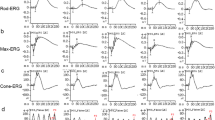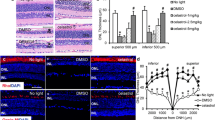Abstract
Berberine (BBR) is a Chinese herb with antioxidant and anti-inflammatory properties. In a previous study, we found that BBR had a protective effect against light-induced retinal degeneration in BALB/c mice. The purinergic P2X7 receptor (P2X7R) plays a key role in retinal degeneration via inducing oxidative stress, inflammatory changes, and cell death. The aim of this study was to investigate whether BBR can induce protective effects in light damage experiments and whether P2X7R can get involved in these effects. C57BL/6 J mice and P2X7 knockout (KO) mice on the C57BL/6 J background were used. We found that BBR preserved the outer nuclear layer (ONL) thickness and retinal ganglion cells following light stimulation. Furthermore, BBR significantly suppressed photoreceptor apoptosis, pro-apoptotic c-fos expression, pro-inflammatory responses of Mϋller cells, and inflammatory factors (TNF-α, IL-1β). In addition, protein levels of P2X7R were downregulated in BBR-treated mice. Double immunofluorescence showed that BBR reduced overexpression of P2X7R in retinal ganglion cells and Mϋller cells. Furthermore, BBR combined with the P2X7R agonist BzATP blocked the effects of BBR on retinal morphology and photoreceptor apoptosis. However, in P2X7 KO mice, BBR had an additive effect resulting in thicker ONL and more photoreceptors. The data suggest that the P2X7 receptor is involved in retinal light damage, and BBR inhibits this process by reducing histological impairment, cell death, and inflammatory responses.





Similar content being viewed by others
Data availability
No datasets were generated or analysed during the current study.
References
Wong WL, Su X, Li X, Cheung CMG, Klein R, Cheng CY, Wong TY (2014) Global prevalence of age-related macular degeneration and disease burden projection for 2020 and 2040: a systematic review and meta-analysis. Lancet Glob Health 2:E106. https://doi.org/10.1016/S2214-109X(13)70145-1
Falavarjani KG, Nguyen QD (2013) Adverse events and complications associated with intravitreal injection of anti-VEGF agents: a review of literature. Eye 27:787. https://doi.org/10.1038/eye.2013.107
Fan H, Song JT (2022) Potential mechanisms of macular degeneration protection by fatty fish consumption. Curr Opin Pharmacol 63:102186. https://doi.org/10.1016/j.coph.2022.102186
Sliney DH (2016) What is light? The visible spectrum and beyond. Eye 30:222. https://doi.org/10.1038/eye.2015.252
Boulton ME, Rozanowska MB, Rozanowski B (2001) Retinal photodamage. J Photochem Photobiol B Biol 64:144. https://doi.org/10.1016/S1011-1344(01)00227-5
Organisciak DT, Vaughan DK (2010) Retinal light damage: mechanisms and protection. Prog Retin Eye Res 29:113. https://doi.org/10.1016/j.preteyeres.2009.11.004
Zhou HJ, Zhang HN, Yu AQ, Xie JJ (2018) Association between sunlight exposure and risk of age-related macular degeneration: a meta-analysis. BMC Ophthalmol 18:331. https://doi.org/10.1186/s12886-018-1004-y
Lambert NG, Singh MK, Elshelmani H, Mansergh FC, Wride MA, Padilla M, Keegan D, Hogg RE, Ambati BK (2016) Risk factors and biomarkers of age-related macular degeneration. Prog Retin Eye Res 54:64. https://doi.org/10.1016/j.preteyeres.2016.04.003
Mishra A, Behura A, Kumar A, Naik L, Swain A, Das M, Sarangi SS, Dokania P, Dirisala VR, Bhutia SK, Mishra A, Singh R, Dhiman R (2021) P2X7 receptor in multifaceted cellular signalling and its relevance as a potential therapeutic target in different diseases. Eur J Pharmacol 906:174235. https://doi.org/10.1016/j.ejphar.2021.174235
Drysdale C, Park K, Vessey KA, Huang X, Caruso E, Li Y, Wong J, Wiley JS, Fletcher E, Guymer RH, Gu B (2022) P2X7-mediated alteration of membrane fluidity is associated with the late stages of age-related macular degeneration. Purinergic Signal 18:469. https://doi.org/10.1007/s11302-022-09894-y
Platania CBM, Drago F, Bucolo C (2022) The P2X7 receptor as a new pharmacological target for retinal diseases. Biochem Pharmacol 198:114942. https://doi.org/10.1016/j.bcp.2022.114942
Notomi S, Hisatomi T, Murakami Y, Terasaki H, Sonoda S, Asato R, Takeda A, Ikeda Y, Enaida H, Sakamoto T, Ishibashi T (2013) Dynamic increase in extracellular ATP accelerates photoreceptor cell apoptosis via ligation of P2RX7 in subretinal hemorrhage. PLoS One 8:e53338. https://doi.org/10.1371/journal.pone.0053338
Notomi S, Hisatomi T, Kanemaru T, Takeda A, Ikeda Y, Enaida H, Kroemer G, Ishibashi T (2011) Critical involvement of extracellular ATP acting on P2RX7 purinergic receptors in photoreceptor cell death. Am J Pathol 179:2798. https://doi.org/10.1016/j.ajpath.2011.08.035
Habtemariam S (2016) Berberine and inflammatory bowel disease: a concise review. Pharmacol Res 113:592. https://doi.org/10.1016/j.phrs.2016.09.041
Wang LH, Li XL, Li Q, Fu Y, Yu HJ, Sun YQ, Zhang L, Shan HL (2012) Berberine alleviates ischemic arrhythmias via recovering depressed Ito and ICa currents in diabetic rats. Phytomedicine 19:206. https://doi.org/10.1016/j.phymed.2011.11.002
Lu QK, Fu YF, Li H (2022) Berberine and its derivatives represent as the promising therapeutic agents for inflammatory disorders. Pharmacol Rep 74:297. https://doi.org/10.1007/s43440-021-00348-7
Wang K, Feng XC, Chai LW, Cao SJ, Qiu F (2017) The metabolism of berberine and its contribution to the pharmacological effects. Drug Metab Rev 49:139. https://doi.org/10.1080/03602532.2017.1306544
Datta S, Cano M, Ebrahimi K, Wang L, Handa JT (2017) The impact of oxidative stress and inflammation on RPE degeneration in non-neovascular AMD. Prog Retin Eye Res 60:201–218. https://doi.org/10.1016/j.preteyeres.2017.03.002
Kang Q, Yang C (2020) Oxidative stress and diabetic retinopathy: molecular mechanisms, pathogenetic role and therapeutic implications. Redox Biol 37:101799. https://doi.org/10.1016/j.redox.2020.101799
Fu DX, Yu JY, Connell AR, Yang SH, Hookham MB, McLeese R, Lyons TJ (2016) Beneficial effects of berberine on oxidized LDL-induced cytotoxicity to human retinal Mϋller cells. Invest Ophth Vis Sci 57:3369. https://doi.org/10.1167/iovs.16-19291
Song DL, Song JT, Wang CG, Li YF, Dunaief JL (2016) Berberine protects against light-induced photoreceptor degeneration in the mouse retina. Exp Eye Res 145:1. https://doi.org/10.1016/j.exer.2015.10.005
Lu L, Huang JJ, Xue X, Wang T, Huang ZQ, Li JM (2021) Berberine regulated miR150-5p to inhibit P2X7 receptor, EMMPRIN and MMP-9 expression in oxLDL induced macrophages. Front Pharmacol 12:639558. https://doi.org/10.3389/fphar.2021.639558
Guo Y, Pope C, Cheng X, Zhou H, Klaassen CD (2011) Dose-response of berberine on hepatic cytochromes P450 mRNA expression and activities in mice. J Ethnopharmacol 138(1):111–118. https://doi.org/10.1016/j.jep.2011.08.058
Guan C, Qiao S, Lv Q, Cao N, Wang K, Dai Y, Wei Z (2018) Orally administered berberine ameliorates bleomycin-induced pulmonary fibrosis in mice through promoting activation of PPAR-γ and subsequent expression of HGF in colons. Toxicol Appl Pharmacol 343:1–15. https://doi.org/10.1016/j.taap.2018.02.001
Hu H, Lu WN, Zhang M, Zhang XL, Argall AJ, Patel S, Lee GE, Kim YC, Jacobson KA, Laties AM, Mitchell CH (2010) Stimulation of the P2X7 receptor kills rat retinal ganglion cells in vivo. Exp Eye Res 91:425. https://doi.org/10.1016/j.exer.2010.06.017
Puthussery T, Fletcher E (2009) Extracellular ATP induces retinal photoreceptor apoptosis through activation of purinoceptors in rodents. J Comp Neurol 513:430. https://doi.org/10.1002/cne.21964
Newman EA (2015) Glial cell regulation of neuronal activity and blood flow in the retina by release of gliotransmitters. Philos T R Soc B 370:20140195. https://doi.org/10.1098/rstb.2014.0195
Harada T, Harada C, Nakayama N, Okuyama S, Yoshida K, Kohsaka S, Matsuda H, Wada K (2000) Modification of glial-neuronal cell interactions prevents photoreceptor apoptosis during light-induced retinal degeneration. Neuron 26:533. https://doi.org/10.1016/S0896-6273(00)81185-X
Xue B, Xie YT, Xue Y, Hu N, Zhang GW, Guan HJ, Ji M (2016) Involvement of P2X7 receptors in retinal ganglion cell apoptosis induced by activated Muller cells. Exp Eye Res 153:42. https://doi.org/10.1016/j.exer.2016.10.005
Bhansali P, Rayport I, Rebsam A, Mason C (2014) Delayed neurogenesis leads to altered specification of ventrotemporal retinal ganglion cells in albino mice. Neural Dev 9:11. https://doi.org/10.1186/1749-8104-9-11
García-Ayuso D, Di Pierdomenico J, Vidal-Sanz M, Villegas-Pérez MP (2019) Retinal ganglion cell death as a late remodeling effect of photoreceptor degeneration. Int J Mol Sci 20:4649. https://doi.org/10.3390/ijms20184649
del Olmo-Aguado S, Manso AG, Osborne NN (2012) Light might directly affect retinal ganglion cell mitochondria to potentially influence function. Photochem Photobiol 88:1346. https://doi.org/10.1111/j.1751-1097.2012.01120.x
Iandiev I, Wurm A, Hollborn M, Wiedemann P, Grimm C, Remé CE, Reichenbach A, Pannicke T, Bringmann A (2008) Muller cell response to blue light injury of the rat retina. Invest Ophthalmol Vis Sci 49:3559. https://doi.org/10.1167/iovs.08-1723
Reichenbach A, Wurm A, Pannicke T, Iandiev I, Wiedemann P, Bringmann A (2007) Mϋller cells as players in retinal degeneration and edema. Graef Arch Clin Exp 245:627. https://doi.org/10.1007/s00417-006-0516-y
Ventura ALM, dos Santos-Rodrigues A, Mitchell CH, Faillace MP (2019) Purinergic signaling in the retina: from development to disease. Brain Res Bull 151:92. https://doi.org/10.1016/j.brainresbull.2018.10.016
Kerur N, Hirano Y, Tarallo V, Fowler BJ, Bastos-Carvalho A, Yasuma T, Yasuma R, Kim Y, Hinton DR, Kirschninget CJ (2013) TLR-independent and P2X7-dependent signaling mediateAluRNA-induced NLRP3 inflammasome activation in geographic atrophy. Invest Ophthalmol Vis Sci 54:7395. https://doi.org/10.1167/iovs.13-12500
Vivoli E, Cappon A, Milani S, Piombanti B, Provenzano A, Novo E, Masi A, Navari N, Narducci R, Mannaioni G, Moneti G, Oliveira CP, Parola M, Marra F (2016) NLRP3 inflammasome as a target of berberine in experimental murine liver injury: interference with P2X7 signaling. Clin Sci 130:1793. https://doi.org/10.1042/CS20160400
Yao MJ, Fan XD, Yuan B, Takagi N, Liu S, Han X, Ren JG, Liu JX (2019) Berberine inhibits NLRP3 inflammasome pathway in human triple-negative breast cancer MDA-MB-231 cell. BMC Complem Altern M 19:216. https://doi.org/10.1186/s12906-019-2615-4
Funding
This work was supported by grants from Eye Hospital of China Academy of Chinese Medical Sciences Scientific Research fund (202001), and China Academy of Chinese Medical Sciences Innovation Fund (CI2021A02608).
Author information
Authors and Affiliations
Contributions
Shan-Shan Ye and Jian-Tao Song contributed to the conception and design of the study. Shan-Shan Ye drafted the manuscript and performed most of the experiments. Jia-Ning Wang, Ya-Fei Zhao, Le-Shu Dai, Ji-Zhou Zhang, Yan-Qin Zuo participated in some of the experiments. Shan-Shan Ye and Jia-Ning Wang analyzed the data. All authors contributed to manuscript revision, and have read and given final approval of the submission.
Corresponding author
Ethics declarations
Ethical approval
The animal study was reviewed and approved by the Institutional Review Board of Chengdu University of Traditional Chinese Medicine (Chengdu, China).
Conflict of interest
Shan-Shan Ye declares that he/she has no conflict of interest.
Jia-Ning Wang declares that he/she has no conflict of interest.
Ya-Fei Zhao declares that he/she has no conflict of interest.
Le-Shu Dai declares that he/she has no conflict of interest.
Ji-Zhou Zhang declares that he/she has no conflict of interest.
Yan-Qin Zuo declares that he/she has no conflict of interest.
Jian-Tao Song declares that he/she has no conflict of interest.
Additional information
Publisher's Note
Springer Nature remains neutral with regard to jurisdictional claims in published maps and institutional affiliations.
Supplementary Information
Below is the link to the electronic supplementary material.
Rights and permissions
Springer Nature or its licensor (e.g. a society or other partner) holds exclusive rights to this article under a publishing agreement with the author(s) or other rightsholder(s); author self-archiving of the accepted manuscript version of this article is solely governed by the terms of such publishing agreement and applicable law.
About this article
Cite this article
Ye, SS., Wang, JN., Zhao, YF. et al. Purinergic P2X7 receptor involves in anti-retinal photodamage effects of berberine. Purinergic Signalling (2024). https://doi.org/10.1007/s11302-024-09999-6
Received:
Accepted:
Published:
DOI: https://doi.org/10.1007/s11302-024-09999-6




